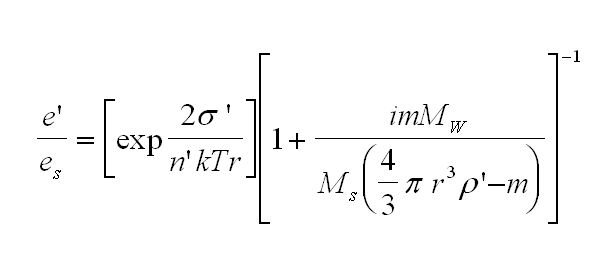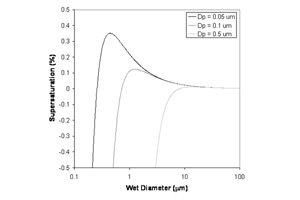Warm Clouds
Warm clouds consist entirely of droplets which have been formed by condensation onto aerosol particles. Aerosol particles respond to changes in humidity in different ways depending on their chemical composition and solubility. Particles which are soluble or hydrophilic (water loving) take on water as humidity increases and increase in size. Above a certain relative humidity soluble particles will deliquesce – the solid particle dissolves in the water it has taken on and becomes a tiny liquid drop, but not yet a cloud drop. For many soluble salts deliquescence happens at relative humidities around 60 – 80%. These droplets exist in equilibrium with water vapour in the surrounding air. The growth of such particles with increase in relative humidity is expressed by the Köhler equation and is a function of the size and chemical composition of the particle.

Where e’ = vapour pressure of air adjacent to a droplet of given radius r; σ’ and n’ = surface energy and number density of water molecules in the solution respectively; m = mass of salt dissolved in droplet; i = no. of ions each salt molecule dissociates into;
MS = molecular mass of salt and Mw = molecular mass of water.
As humidity increases, aerosol continues to swell, even after vapour saturation is reached. Once a critical supersaturation is reached, corresponding to the peak of the Köhler curve for that particle, a particle becomes activated as a cloud droplet. Activated particles are no longer in stable equilibrium with the vapour phase, but are able to continue to grow by vapour deposition provided that conditions remain supersaturated. Droplet size is determined by the number of particles activated and the amount of water vapour available for condensation which is generally determined by the vertical height of an adiabatic ascent. If droplets are able to grow to a sufficient size and the cloud exists for a sufficient length of time droplets will coalesce as they collide with each other through random motion, gravitational settling, or motion within the dynamics of the cloud system. Through coalescence large droplets are produced. These large droplets have a larger gravitational settling velocity than smaller particles and begin to fall out of the cloud. In doing so they are moving more rapidly with respect to other cloud droplets, so the rate of coalescence increases and precipitation drops are formed.
